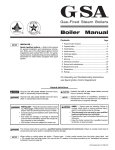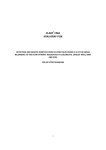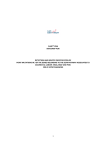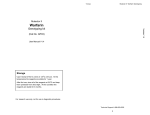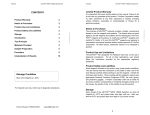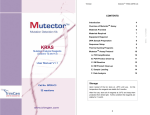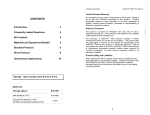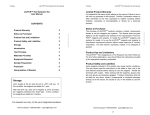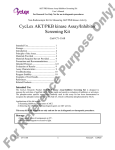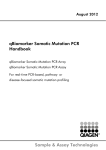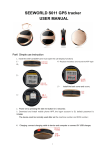Download Manual - Trimgen
Transcript
PIK3CA Mutation Analysis Reagents User Manual V1.5 . eQ-705LC PIK3CA Mutation Analysis Reagents User Manual V1.5 Cat No. GP08 32 reactions 1 PIK3CA Mutation Analysis Reagents User Manual V1.5 Storage Upon receipt of the kit, store at –20oC until use. temperature the reagents are stable for 6 months. At this After first use, store all of the reagents at 2-8oC and keep them protected from direct light. At this condition the reagents are stable for 1 month. For research use only, not for use in diagnostic procedures 2 PIK3CA Mutation Analysis Reagents User Manual V1.5 CONTENTS Introduction 5 Overview of MutectorTM Assay 6 Materials Provided 7 Materials Required 8 Equipment Required 8 DNA Sample Preparation 9 Sequencer Setup 9 Thermal Cycling Programs 10 MutectorTM Assay Protocol 11 Data Analysis 16 Troubleshooting 18 3 PIK3CA Mutation Analysis Reagents User Manual V1.5 Notice to Purchaser The MutectorTM kit is provided as research use only, not for use in diagnostic procedures. The purchaser must determine the suitability of the product for their particular use. TRIMGEN DISCLAIMS ALL WARRANTIES WITH RESPECT TO THIS DOCUMENT, EXPRESSED OR IMPLIED, INCLUDING BUT NOT LIMITED TO THOSE OF MERCHANTABILITY OR FITNESS FOR A PARTICULAR PURPOSE. TO THE FULLEST EXTENT ALLOWED BY LAW, IN NO EVENT SHALL TRIMGEN BE LIABLE, WHETHER IN CONTRACT, TORT, WARRANTY, OR UNDER ANY STATUTE OR ON ANY OTHER BASIS FOR SPECIAL, INCIDENTAL, INDIRECT, PUNITIVE, MULTIPLE OR CONSEQUENTIAL DAMAGES IN CONNECTION WITH OR ARISING FROM THIS DOCUMENT, INCLUDING BUT NOT LIMITED TO THE USE THEREOF, WHETHER OR NOT FORESEEABLE AND WHETHER OR NOT TRIMGEN IS ADVISED OF THE POSSIBILITY OF SUCH DAMAGES. Limited Product Warranty It is imperative that the users strictly adhere to this manual. Failure to do so will void TrimGen's guarantee of this product. TrimGen Corporation makes no other warranties of any kind, expressed or implied, including without limitation, warranties of merchantability or fitness for a particular purpose. License The purchase of MutectorTM kit includes a limited, nonexclusive license to use the kit. This license does not grant rights to reproduce or modify the MutectorTM kit for resale, or to use the MutectorTM kit to manufacture commercial products without written approval of TrimGen Corporation. No other license, expressed, implied or by estoppels is granted. Product Safety and Liabilities When working with the kit reagents, always wear a lab coat, disposable gloves, and protective goggles. TrimGen Corporation shall not be liable for any direct, indirect, consequential or incidental damages arising out of the misuse, the results of use, or the inability to use this product. Trademarks The trademarks mentioned herein are the property of TrimGen or their respective owners. TrimGen Corporation. All rights reserved. Information in this document is subject to change without notice. 4 PIK3CA Mutation Analysis Reagents User Manual V1.5 Introduction Phosphoinositide-3-kinase (PI3K) plays an important role in the EGFR signaling pathway. The PI3K activates the serine/threonine kinase AKT, which in turn regulates several signaling pathways controlling cell survival, growth and proliferation. The gene, PIK3CA, encoding the catalytic subunit of the enzyme, has been found to mutate frequently in human cancers. The studies found that the PI3KCA mutations in cancer cells associated with early recurrence, poor prognosis and drug resistance. The MutectorTM PIK3CA Mutation Analysis Reagents uses TrimGen’s proprietary technology called Shifted Termination Assay (STA) to detect the following 5 mutations: E542K (G1624A, exon 9) E545K (G1633A, exon 9) E545G (A1634G, exon 9) H1047R (A3140G, exon 20) H1047L (A3140T, exon 20) The kit contains reagents enough for 32 reactions. * Shifted Termination Assay (STA) Shifted Termination Assay is a proprietary multi-base primer extension method. STA technology extends primers by multiple bases to increase signal strength and fragment size, creating mutation peaks that are easily distinguished from wild type. Mutations are confirmed by both peak color and size. The STA technology can detect low-level mutations often missed by sequencing. Mutant Wild type Mutant x Wild type x Fragment analysis STA reaction 5 PIK3CA Mutation Analysis Reagents User Manual V1.5 Overview of MutectorTM Assay Total assay time: 2-3 hours; hands-on time: 10-20 min Step 1 PCR amplification 1.5 hours* * Time varies depending on the type of thermal cycler used Step 2 PCR product clean-up 30 min Mutation detection (ST reaction) Step 3 40 min* * Time varies depending on the type of thermal cycler used Step 4 Load sample 5 min to sequencer Capillary Electrophoresis Wild type Fragment analysis 30-40 min* Mutation * Time varies depending on the type of sequencer 6 PIK3CA Mutation Analysis Reagents User Manual V1.5 Materials Provided: The MutectorTM PI3K Mutation Analysis Reagents can perform 32 reactions. Materials Quantity Master Mix 700 μL PCR-P 08 50 μL C-UP1 40 μL C-UP2 40 μL C-UP Buffer 430 μL ST-D* 430 μL DP-08 80 μL M-08 50 μL Loading Bfx* 1000 μL * Light sensitive: Keep these reagents protected from direct light. Reagent Description: Master Mix Reagents for DNA amplification. PCR-P 08 PCR primer mix for amplification of PIK3CA gene. C-UP1 and C-UP2 Enzymes for cleanup of PCR products. C-UP Buffer Buffer for C-UP1 and C-UP2. ST-D (Light sensitive) Pre-mixed STA reagents for mutation detection. DP-08 Detection primers for PIK3CA gene. M-08 Mutant and wild type control DNA for PIK3CA gene. The controls are sufficient for 32 test runs. Loading Bfx (Light sensitive) Loading buffer for ABI capillary type sequencers and special fluorescence-labeled size standards. 7 PIK3CA Mutation Analysis Reagents User Manual V1.5 Materials Required: 0.2 ml PCR tubes (8-well strip tube) DS-32 Matrix Standard Kit (Applied Biosystems Cat. No. 4345831). The calibration defines the color definition on the sequencer to read the test results correctly. This is a one-time set up procedure for all Mutector assays. Equipment Required: Thermal Cycler: Any type of thermal cycler is acceptable for performing the assay. Sequencer: Any type of Applied Biosystems’s Genetic Analyzer or comparable capillary electrophoresis equipment. Analysis Software: GeneMapper® or GeneScan® for fragment analysis 8 PIK3CA Mutation Analysis Reagents User Manual V1.5 DNA Sample Preparation: Any commercially available DNA extraction kit is acceptable. Paraffin (FFPE) tissue samples A kit specially designed for FFPE sample DNA extraction is available from TrimGen. Product information: WaxFreeTM DNA for 50 samples (Cat. # WF-50) WaxFreeTM DNA for 100 samples (Cat. # WF-100) DNA concentration: When using a column or bead DNA extraction method, adjust the final concentration of extracted DNA to 20-80 ng /μL When using TrimGen’s DNA preparation kit, follow the preparation kit protocol to perform the PCR reaction. Sequencer Setup: First time users should set up the analysis program for the ABI sequencer (one time setup). After setup, the program can perform data analysis for all Mutector™ II tests. Please choose either GeneMapper® or GeneScan® to analyze your data. GeneMapper® Analysis Step I. GeneMapper® Setup www.trimgen.com/docs/PartI-GeneMapper-Setup.pdf Step II. Data Collection® Software Setup www.trimgen.com/docs/PartII-Data-Collection-Setup.pdf Step III. Data Analysis Using GeneMapper® www.trimgen.com/docs/PartIII-Data-Analysis-GeneMapper.pdf GeneScan® Analysis Step I. Data Collection® Software Setup www.trimgen.com/docs/PartII-Data-Collection-Setup.pdf Step II. GeneScan® Setup and Data Analysis www.trimgen.com/docs/PartIV-Genescan.pdf 9 PIK3CA Mutation Analysis Reagents User Manual V1.5 Important Spectral calibration is required before running the test To read the test results correctly, the sequencer needs to be calibrated with the DS-32 calibration kit (Applied Biosystems Cat. No. 4345831). This is a one-time calibration to set up the correct spectral channels. Refer to the DS-32 Matrix standards kit manual to perform spectral calibration. Thermal Cycling Programs: Program 1 (PCR amplification) 1 cycle 94oC 5 min 35 cycles 94oC 30 sec 52oC 30 sec 72oC 30 sec 1 cycle 72oC 5 min Hold at 4oC Program 2 (C-UP treatment) 37oC 25 min 95oC 5 min Hold at 4oC Program 3 (STA reaction) 1 cycle 94oC 4 minute 20 cycles 94oC 20 sec 55oC 30 sec 70oC 20 sec Hold at 4oC 10 PIK3CA Mutation Analysis Reagents User Manual V1.5 MutectorTM Assay Protocol: A. PCR Amplification Thaw all reagents and keep on ice. before use. Spin down the reagents Negative and positive controls are recommended to be run each time. A.1. Prepare PCR reaction mix (PM): The PCR reaction mix can be prepared by using the following formula: + 2*) x 1.1** = Master Mix = 18 x ( μL (Total # of samples) + 2*) x 1.1** = PCR-P 08 = 1 x ( μL (Total # of samples) *2 tubes for negative and positive sample controls. ** Adjustment for pipetting error. Collect one 2 mL tube and label with “PM” (PCR reaction mix). Transfer the above reagents to the tube and mix the contents. This is the master mix for PCR amplification. A.2. Collect 0.2 mL PCR strip tubes and label the tubes as follows: Sample 1, 2, 3 …… Neg Pos 1 3 2 Neg: Negative control Pos: Positive control 11 4 5 PIK3CA Mutation Analysis Reagents User Manual V1.5 A.3. Add 19 μL of PM into each of the tubes. A.4. Add 1 μL of negative control sample to the “Neg” tube. A.5. Add 1 μL of positive control sample to the “Pos” tube. A.6. Add 1-2 μL of sample DNA (20-80 ng/L) to each sample tube. When using TrimGen’s WaxFree kit for paraffin sample DNA extraction, add 1 μL of the final extract to each sample tube. A.7. Place the PCR tubes in a thermal cycler and run Program 1. Program 1 1 cycle 35 cycles 1 cycle 94oC 5 min 94oC 30 sec 52oC 30 sec 72oC 30 sec 72oC 5 min Hold at 4oC Note: Optional: To verify the PCR products, run 5l of the PCR products on a 1-2% agarose gel. The correct band size is around 100 bp. The procedure can be temporarily stopped after Program 1. The PCR product can be stored at 4oC for next day test. During the PCR amplification process, prepare steps B1-B2. 12 PIK3CA Mutation Analysis Reagents User Manual V1.5 B. PCR Product Clean-up B.1. Prepare C-UP Mix: C-Buffer = 10 μL x ( μL ) x 1.1** = # of PCR tubes C-UP1 = 1.0 μL x ( ) x 1.1** = μL # of PCR tubes C-UP2 = 1.0 μL x ( ) x 1.1** = μL # of PCR tubes Mix the reagents and spin down ** For pipetting error. B.2. Collect 0.2 mL strip tubes, one tube for each PCR reaction, for example, if you have 8 tubes for PCR, then collect 8 tubes. Label the tubes with “C” and sample name in the same manner as the PCR tubes B.3. Add 11 μL of C-UP mix to each new tube. B.4. Transfer 4 μL of each sample’s PCR product to corresponding CUP tube. B.5. Cap the tubes, mix the contents and spin all tubes. B.6. Incubate the tubes in a thermal cycler using Program 2. Program 2 37oC for 25 min 95oC for 5 min Hold at 4oC During the product clean-up incubation, prepare steps C1-C4. 13 PIK3CA Mutation Analysis Reagents User Manual V1.5 C. STA Mutation Detection C.1. Collect one 2 mL tube and label with “ST”. Mix the ST-D reagent and DP-08 (detection primer) to make the ST Mix. The ST Mix can be prepared by using the following formula: ST Mix ST-D = 11 x ( μL + 1*) x 1.1** = Total # of C-UP samples DP-08 = 2 x ( μL + 1*) x 1.1** = Total # of C-UP samples *One extra tube for M-08 (Mutant Controls) ** Adjustment for pipetting error. Add the reagents to the tube and mix gently. C.2. Collect 0.2 ml strip tubes, one tube for each C-UP treated sample. Add one new tube for M-08 (Mutant Controls) and label the tube with CTL. Sample 1, 2, 3 …. CTL Neg Pos 1 3 2 4 5 New tube for M-08 (mutant controls) The M-08 (mutant controls) is designed for data analysis and must be run each time. C.3. Add 13 μL of ST Mix into each tube. C.4. Transfer 2 μL of C-UP treated PCR product to each corresponding tube. C.5. Add 2 μL of M-08 into the CTL tube. C.6. Cap the tubes, mix the contents and spin down all tubes. C.7. Place the tubes into the thermal cycler and perform the ST reaction using Program 3. 14 PIK3CA Mutation Analysis Reagents User Manual V1.5 Program 3 1 cycle 94oC 4 min 20 cycles 94oC 20 sec 55oC 30 sec 70oC 20 sec Hold at 4oC D. Sample Loading D.1. Add 15 μL of the Loading Buffer to each well of a sequencer adapter plate. D.2. Transfer 5 μL of the ST products into each well. Confirm and remove any bubbles in the well. D.3. Load the plate into the sequencer and run the preset Data Collection Program (GeneMapper or GeneScan). 15 PIK3CA Mutation Analysis Reagents User Manual V1.5 E. Data Analysis E.1. Open the analysis software GeneMapper or Genescan. E.2. Follow the instruction to add the data for analysis. The instructions are provided online: GeneMapper: www.trimgen.com/docs/PartIII-Data-AnalysisGeneMapper.pdf GeneScan: www.trimgen.com/docs/PartIV-Genescan.pdf. E.3. Confirm results of mutant control M-08 In the sample plot window (shows graphic data), find the results of the mutant control (M-08). Read the peaks from left to right, and record peak size in Test Report From (download the Form from http://www.trimgen.com/docs/M2-report-form-GP08.xls). The peak size of the Mutant Controls is the standard for sample analysis. Result of M-08 (mutant controls) 3 2 1 4 6 5 8 9 7 10 Peak # Peak Color Peak Size* 1 Red 34.04 Mutation - E542K (G1624A) 2 Black 35.62 Wildtype - 542WT (1624WT) 3 Red 41.44 Internal control 4 Blue 44.17 Mutation - E545G (A1634G) 5 Blue 45.06 Wildtype - 545WT (1633 WT) 6 Black 45.50 Wildtype - 545WT (1634 WT) 7 Red 46.34 Mutation - E545K (G1633A) 8 Blue 49.83 Mutation - H1047R (A3140G) 9 Red 50.79 Mutation - H1047L (A3140T) 10 Black 52.28 Wildtype - 1047WT (3140WT) Interpretation *Peak size may vary slightly depending on instrument, polymer type and the length of capillary. 16 PIK3CA Mutation Analysis Reagents User Manual V1.5 E.4. Data analysis for sample (ref http://trimgen.com/docs/PI3K-dataanalysis.pdf ) Four wild type peaks are observed in every sample. If all four peaks are not observed, it indicates that the DNA amplification failed (see troubleshooting section) or the sample is 100% mutation(s), such as mutant cell lines. If sample contains mutant DNA, the mutation(s) will show as additional peak(s). Compare the peak size and color with the mutant controls (M-08). The peak size may be slightly shifted due to migration differences between individual capillary tubes (Comparing the wild type peak of the sample with the wild type peak of the Mutant Controls can identify the migration shift). Fill in the peak size to the Test Report From. Any peak that does not match the Mutant Controls will not be considered as evidence of a mutation. Example of assay result Sample: FFPE sample, one section (1 x 0.5 cm, 10 µm). DNA extraction: WaxFree DNA kit. Wild type Wild type (2 peaks) H1047R (A3140G) Blue peak Wild type 17 PIK3CA Mutation Analysis Reagents User Manual V1.5 F. Troubleshooting F.1. “Color leak-through” When the sample DNA concentration is too high, the STA reaction generates a strong fluorescent signal (>5,000 rfu). Fluorescence spillover into other channels will occur, for example, the black peak of the wild type signal may be observed in the red and/or blue channels. The “leak-through” peaks are the same size as the original peak and should not be considered mutation peaks. F.2. The size standard is too high The height of the size standard varies with STA reaction efficiency. Generally, the size standard intensity (green color) is 2,000-3,000 rfu. When the STA efficiency is too low (poor DNA quality, improper handling of STA reagents), the size standard may reach 5,000-7,000 rfu. Diluting the size standard with deionized formamide will reduce the size standard signal. F.3. The signal peak is too high The assay chemistry is optimized to detect mutations in samples with low DNA concentration, such as DNA from a fine needle aspiration (FNA) sample. For regular FFPE samples, the assay signal may be too high to analyze (peak height >8000, the top of the peak is not visible or the peak is highlighted with pink color). Diluting the final STA product with de-ionized water can effectively reduce the signal. Do not dilute the assay reagents as it will cause improper enzyme reactions and generate false results. Each laboratory has different PCR instruments, and the signal strength may vary among the laboratories. The first time user should define the dilution factor (2-20 times dilution) during initial validation. Once the dilution factor is determined, most samples will have a consistent result. F.4. Data failed to be analyzed The size standard may be miscalculated by the sequencer. Check the size standard and manually correct it (see the sequencer’s instruction manual). Reanalyze the data after correction of size standard. 18 PIK3CA Mutation Analysis Reagents User Manual V1.5 Check the raw data, if the signals from the sample and size standard are too low, the capillary tube may be blocked by a bubble. The sample needs to be re-loaded. If the sample signal is too strong and the size standard is too low, the STA products will compete with the size standard DNA to enter the capillary tube. Diluting the final STA product with deionized water and reloading the sample will easily resolve this problem. F.6. Graphic data does not automatically appear Check the raw data, if the signals from the sample and size standard are too low, the capillary tube is blocked by a bubble. The sample needs to be re-loaded. When adding a sample to the loading plate, do not use the pipettor to mix the sample, as this will generate bubbles. The sample DNA in the loading plate will automatically enter into the capillary tube by electric current. If the sample signal is too strong and the size standard is too low, the ST products will compete with the size standard DNA to enter the capillary tube. When the size standard is too low, the software can not detect the size standard correctly and the program will not show the graphic data. Diluting the final ST product with de-ionized water and reloading the sample will easily resolve this problem. The size standard may have miscalculated. Check the size standard and manually correct the size standard (see the sequencer’s instruction manual). Reanalyze the data after correction of size standard. F.7. Missing wild type peak(s) The wild type peaks are built-in reaction controls for sample DNA amplification, these peaks should appear in all samples. If wild type peaks are not observed, it indicates that the PCR amplification failed. The possible causes could be poor DNA quality, low DNA concentration or PCR inhibitor in the DNA sample. F.8. Background noise The background of the assay is normally low. When the STA reaction is too strong (peak signal over 8000 rfu and highlighted 19 PIK3CA Mutation Analysis Reagents User Manual V1.5 with pink color), background noise (also called “pull up”) can be seen. To resolve this issue, simply dilute the final ST product with de-ionized water and re-load the sample. Overloading DNA is another cause of increased background noise. Reducing the input DNA amount will resolve this issue. F.8. Unexpected peak Presence of a peak that does not match any of the peaks in the Mutation Control The Mutation Control contains 13 peaks (wild-type and mutant peaks). If you see a peak that does not match the Mutation Control, please contact Technical Support for further analysis. F.9. Mutation peak cut-off For some samples, there could be a small peak observed in one of the mutation positions. To verify the peak, you need to confirm the signal strength of the wild type peak. If the wild type peak is too high (cannot see the top of the peak and the peak is highlighted with pink color), your ST reaction is too strong and the small peak may be a “pull up” from background noise. Follow the trouble shooting F2 to dilute the final product of ST reaction with de-ionized formamide. After dilution, reload the sample. If you can see the top of the wild type peak, then use the following calculation to identify the small peak: Ratio = (Height of mutant peak) / (Height of wild type peak) If the ratio is larger than 0.08, the peak is considered to be a mutation peak (this ratio does not represent the percentage of the mutation present in the sample). Otherwise the peak is background pull up and does not indicate the presence of a mutation in the sample. 20






















